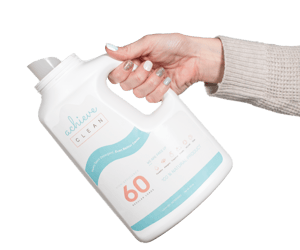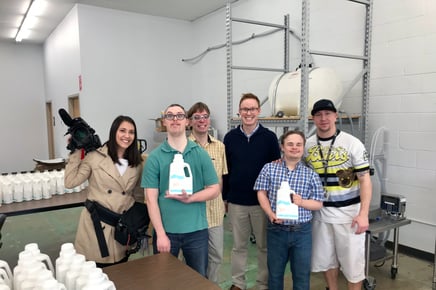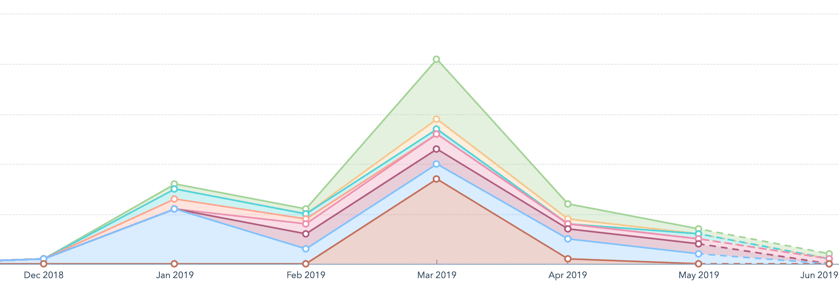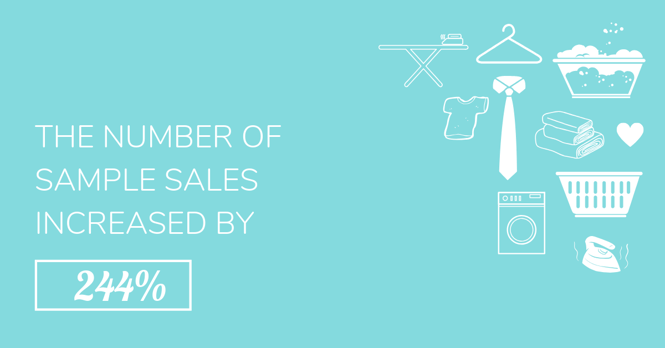Achieve Services is an outstanding non-profit in Minnesota that dedicates its time and resources to employing adults with disabilities and finding them other enriching opportunities. When they found out their government funding would be cut by nearly 35% in 2020 they knew they needed to find a different source of incoming revenue to support their participants and supply things like transportation and supplies to keep the lights on.
Real Good Detergent, Even Better Cause.

Their solution was Achieve Clean — an all natural laundry detergent that provided jobs for Achieve Services participants as well as an easy way for people to donate to a good cause while doing the one thing they [probably] loathed … laundry.
Achieve Clean partnered with local companies to produce the product at a nearby production facility, and got right to work filling orders and shipping bottles to homes across Minnesota. But they were looking for more. They were craving a new face for their product that represented their team, so they reached out to us about creating a new brand.
So, they launched a polished new brand, logo, and website. We also included an inbound campaign with elements like calls-to-action on the website, a paid media campaign, and social media posts to generate some new sales.
But it was also a great opportunity for some public relations.
PR Doesn't stand for "poor roi"...
...it stands for People & Relationships. We knew Achieve Clean needed traditional media exposure that told the story behind their cause and touched the hearts of Minnesotans across the state. So, we started crafting a PR plan that targeted Achieve Clean's buyer personas: people who cared about their community and wanted to purchase detergent that was easy on their little ones’ skin but harsh on the messes they left behind.
The PR strategy combined traditional media outreach and influencer marketing efforts during a killer two-week campaign. The purpose of the strategy was to speak to Achieve Clean's buyer personas on a local and national scale using the following PR tactics:
- An on-site interview with Achieve Clean employees at the production facility
- A TV spot on a local station’s Saturday morning show
- An online feature article that shared a copy of the TV spot by the same local station
- A featured blog post and online giveaway hosted by a trusted natural-living influencer

The results were astounding. But in order to figure out whether or not a PR strategy really made the difference, we needed to look into the data.
POUR on the results
The first step? Collect all of the website, sales, and marketing data housed in HubSpot and Woocommerce from the day the website launched to the day before our PR campaign kicked off. This ended up being around 12 weeks.
Next, we compared that data to the website, marketing, and sales data collected over the span of our two-week PR campaign. Then came the magic. No seriously, check out the snapshot below showing the number of website sessions over the span of website launch to current day. Can you guess when the PR kicked in? If you guessed the end of March, you're correct.

But that's not all. We saw major improvements in website page bounce rates, new HubSpot contacts, new customers, and brand engagement on Twitter and Instagram. Just check out the stats below to see the proof (note: all data from the initial 12 weeks of the year was compared to the data from the two-week PR campaign to produce the results below).
The average number of website sessions per day increased by 453 percent
.png?width=665&height=348&name=AC-Stat-1%20(1).png)
The number of new contacts increased by 239 percent
The number of sample sales increased by 244 percent

Pretty wild, right? But we didn’t stop there — we wanted to know how many of those contacts and sessions came from users who interacted with our influencers and media features. So, we took another look at the trackable links that were used during the two weeks we utilized PR:
- Nearly 28 percent of website sessions came from trackable PR links
- The site’s bounce rate decreased by 28 percent.
- Website users coming from trackable PR links spent 39 percent more time on the website per session than the average user
- At least 41 percent of new contacts came from trackable PR links
- Achieve Clean received more than 400 mentions on Twitter
- The Achieve Clean Instagram account grew 45 percent in followers
It’s been five months since the launch of Achieve Clean’s new brand and website — so what do these results look like year-to-date? Did this PR campaign really provide ROI or was it just another brand awareness tactic?
It was both. But we’ll show you the numbers to prove it to you.
...wait, there's more?
Nearly 17 percent of YTD website sessions came from this PR campaign and so did at least 20% of all new contacts. If that doesn’t show the power of public relations, we don’t know what will.
PR tends to get a bad rap — that it’s only for brand awareness and can’t really impact leads or sales. But the truth is that if you strategically align your efforts and use a marketing automation software like HubSpot to track them, you’ll be able to see the gains in more ways than one
PS - get HubSpot FREE for 30 days! Seriously, it's as easy as clicking the link.
